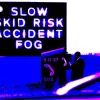There were two reasons to be interested in variable message signs in the 1960s: traffic control and emergency warnings. While Bergo were attempting to find solutions for traffic control, the Ministry was actually more interested in finding ways that electronic signs could be used to make motorways safer.
Their proposed signs were, however, much less clever. A large hooded box was proposed, with a warning triangle on top, and inside three panels on vertical spindles that could be rotated to present a blank face or a warning sign to traffic. The three warnings they proposed were letters: A for accident, I for ice, F for fog.
The design was meant to allow the signs to be used in remote areas where no power supply was available: the signs had no illumination and the motors were to be battery-driven. When it came to installing permanent signs for real a few years later, the Ministry of Transport got around this problem in a different way by just installing a power supply.
This system was not perfect, and was never tried out for real (though AEI had a hand in the communications system eventually developed for a permanent signalling system in the late 1960s), but AEI's engineers had at least spotted and avoided some problems that would come to plague systems that did get trialled on the roads. They suggested that the idea of manual control, meaning operation of the sign by a police officer parking his car and walking over to it, was not efficient and would not allow the sign to respond very quickly to changing conditions. They also recognised that maintaining accurate warnings about fog patches would be almost impossible. This is a problem we still have today.
Elsewhere on
Roads.org.uk...
Skid Risk, Accident, Fog 10 March 2025
For the first time, we can share pictures of the pioneering experiment that lit up the Worcestershire countryside with enormous signs 61 years ago.

